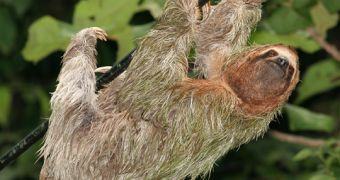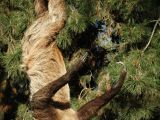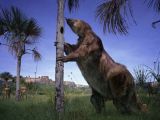Do you know which are the most abundant mammals on the tropical South American forest? Monkeys? Wrong! Sloths...
Sloths are solitary and arboreal (tree dwellers) mammals. Today, there are 2 genera of sloths: three toed sloths (Bradypus) and two toed sloths (Choelepus), each one in its own family (thus, not so closely related). All sloths have three digits on the rear limbs and three, respectively two, in the two genera, as their names point.
They inhabit both virgin and secondary growth forests. In food abundant areas, there are 7 three toed sloths per hectare or 2.7 two toed sloths per hectare. The vital domain of a three toed sloth is 2 hectares, and 2.7 hectares for a two toed sloth. The territory is marked with the secretion of anal glands. Sloths inhabit forests up to 1,800 m (6,000 ft) in altitude.
Sloths really deserve their name: 11 % of the sloths move only 38 m (126 ft) daily, and 38 % cannot move at all for 24 hours. The two toed sloths are more "active": they move more than 38 m daily and are active about 7 hours each day. Moreover, to increase the lazy impression, as sloths are nocturnal, during the day they just sleep or doze.
The three toed sloths have a large arm span. This enables them to have a good grip when climbing trees. The two toed sloths have shorter arms. All sloths have very short Tails, but in the case of the three toed sloths it is visible from the fur (it has 2-9 cm), while in the case of the two toed sloth it is not.
Three toed sloths have 2.5-5.5 kg (5.5-12.2 pounds) in weight and are 41-80 cm long (1.3-2.6 ft), while the two toed sloths are a bit larger: 4-8 kg (9-18 pounds).
By night, sloths ingest large amounts of leaves, especially young ones, but also soft shoots, for 6-10 hours. The preferred species is Cecropia (which is most abundant in secondary growth forests, that's why human activity is not that harmful for sloths); sloths will also eat fruits. The food is approached to the mouth with the "hand". Sloths lack incisor and canine teeth; they have just molars and premolars (which cannot be differentiated) which have a continuous growth, 5+5 on the upper jaw and 4+4 on the lower jaw. They lack roots and have tough surfaces for grinding. In the case of the two toed sloths, the first pair of teeth take the shape of well developed fangs, used for defense.
The leaf fermentation takes place in the stomach, and only 0.2-13.4 % of the stomach's content is processed in 24 hours. That's why the digestion can last more than 26 days. The full stomach's content can make 30 % of the body mass. The cellulose is digested by protozoans and bacteria in the stomach, that's why the gut is short.
Once at each 8 days, the three toed sloth (4 days in the case of the two toed sloths) descend to the ground, digs a hole with its short tail in which it deposes its dry dung. The latrines serve for marking the territory, signaling the presence of the individual in the area.
In the first 6 months of life, the young sloth forms its dietary preferences, through imitating the mother, as this is when the gut flora adapts to the individual's diet.
Sloths move, eat, sleep and breed suspended on their claws. They can hang on two limbs (the two forelimbs, or the two hind limbs, or a hind limb and a fore limb). The claws are 5-6 cm (2-2.4 in) long, laterally flattened and 3 cm (1.2 in) from the last phalanx (toe/finger bone) enters into the claws. Claws are also employed for defense against predators. The claw works through tendons that do not spend muscle power, just like to feet of tree birds. That's why sloths have weakly developed muscles and even dead sloths can remain hung on the trees. Moreover, sloths are extremely light for their size.
They descend to the ground just for defecation and mating. The breeding is not seasonal, and the sex ratio at birth is 1:1 (there is an equal number of males and females) in the case of the three toed sloth. In two toed sloths there are 11 females for one male! The females of the two toed sloths form small groups, while the males are solitary. The mating is made abdomen to abdomen (very rare amongst mammals, humans, bonobo and orangutans being another cases). The male interposes between the female and the branch to which she is hanging. In the case of the two toed sloths, the female hangs with one arm during the mating. The males in three toed sloths have a speculum, a dorsal orange line that marks the position of a gland probably involved in sexual attraction.
Gestation lasts 4-6 months in three toed sloths and 11.5 months in two toed sloths.
Females give birth to one offspring, and they have just a pair of pectoral mammary glands. The young is fed with milk 3-4 weeks and carried by the female for 6-9 months (moment when the young has 15 % of the mother's weight). After one month of age, the young feeds on leaves it can reach from the chest of the mother.
The offspring stay on the ventral part of the mother like in a hammock, but it also can cling on her dorsal part. A female delivers just one offspring per year in three toed sloths and one to every 14-16 months in two toed sloths. Even after 6 months, the young stays around its mother through which communicated through calls. After one year they start the solitary life of a sloth, establishing a territory neighboring that of the mother.
The calls "ai-ai" are also employed for defending the territory, attract a sex partner and are made by blowing air through the nostrils. The young emit sounds with frequencies of 1.9-2.6 kHz, the adults of 2-8 kHz. They also emit for communication ultrasounds that humans cannot hear.
Sloths have small, round faces, and smaller ears and eyes. The eyesight is good and probably binocular, while the hearing is mediocre. Sloths may see in colors. Smell is developed as well.
All mammals have 7 cervical (neck) vertebrae, and the sloths make an exception: three-toed sloths have 8-9 cervical vertebrae, while the two-toes sloths have 6-8 cervical vertebrae. The high number of neck vertebrae allows them to rotate their heads by 180o.
Both male and female sloths have anal and nasal glands for marking their territories. Sloths are good swimmers and they are known to cross the Panama Channel.
Sloths have low energetic needs, due to their reduced movements, claw system of reducing waisted energy and their low and variable body temperature. Sloths normal body temperature is 32oC (while 36.8o C in most other mammals). This determines a very low metabolism (the oxygen consumption (155 ml O2/body kilogram/hour), rhythm of digestion, gestation, and breathing: only 6-8 breaths per minute, very low for their size). This low metabolism, the same like in sloth related species (armadillos and anteaters) is due to the calories poor food. The lack of movement is a good protection for sloths, as predators' eyes are adapted for detecting especially movement.
By the night, sloths lower their body temperature with 3o C (when the environmental temperature can decrease by 8o C). At an environmental temperature of 10o C, they decrease their body temperature by 13-16o C (but not more than 6o C in the case of pregnant females). The temperature of the two toed sloths varies between 24 to 33o C.
To save energy, sloths take sunbaths for increasing their body temperature, just like reptiles do.
The three toed sloths are more resistant to temperature variation; the two toed sloths do not venture into subtropical areas or dry forests (both with higher temperature variances).
Sloths are unique amongst mammals, because their hair fibers grow in an opposite direction to that found in most mammals. The coat is shaggy, coarse and long, making sloths look unkempt. The hair fibers can be 12 cm (4.8 in) long and present cracks in the cortex (outer layer) in which green algae breed (but there are also algae from the groups of Cyanophyta, Chrysophyta, Rhodophyta). The cracks are transversal in three-toed sloths and longitudinal in two toed sloths. The algae give the sloth fur a greenish hue that camouflages the animal in the trees.
The algae support an insect ecosystem (on a sole sloth they may be 120 species of butterflies, 1,000 of beetle and various mites, all feeding on the algae). Sloths lack fleas as they do not have beddings (required by the flea larvae).
These insects' larvae develop in the sloths' feces. Butterflies are more abundant on two toed sloths. These butterflies are from the Pyralidae family, the subfamily of Chrysauginae. The butterflies resulting from dung eating caterpillars look for sloth fur. Male butterflies wait for the females on the sloth fur. Some butterfly species of the genus Bradypodicola are wingless and move rapidly through the sloth's fur. The beetles belong to the genera Trichelium and Uraxys. They are 3 mm long and can be about 1,000 per sloth.
The mites are from the family Macrochelidae and live around the rectum, feeding on the dung. Some associate them with beetle females that lay eggs in the fresh dung.
Three toed sloths can live up to 12 years, while the record in two toed sloths is 31 years 8 months in captivity. Sloths are hunted by cats (jaguar, puma, ocelot, margay), anacondas, large boas, but their main predator is the harpy eagle (the largest bird prey in the world), whose diet is made 22.9 % by two-toes sloths and 8.4 % by tree-toes sloths. This eagle spots the sloths when they take sunbaths, and the two toed sloths fall more often prey to them because they move more than the three toed sloths.
Sloths represent reservoirs of leishmaniosis, which is transmitted by sand flies of the genus Lutzomyia to humans.
Today's sloths are pale vestiges of the sloths' past. 10 million years ago, appeared gigantic ground sloths, which entered North American savannas, while the tree species did not spread more than the southern Mexico.
The fossil number of sloth genera was about 60, split in two groups: Mylondontidae and the others (Megalonychidae-two toed sloths, Megatheridae, Bradypodidae-three toed sloths).
Fossil remains of Mylodon (giant ground sloths) with skin and hair in the Patagonian caves show that the last ground sloths were exterminated by people.
Megatherium, which lived 2 million years ago (Pleistocene) in South America, was 6 m (20 ft) long, 3 tonnes heavy (as big as an Asian elephant). It was related with the modern three-toed sloths.
Megalonichidae were ground sloths that inhabited South America, North America and Antilles, very close relatives of the two-toed sloths.
Nothroteriops which lived in Pleistocene (2 million years ago) in southern US were 2.5 m (8.3 ft) long and weighed 160 kg (356 pounds). The species from the Antilles were encountered by the first Europeans reaching the islands five centuries ago, and were 20-70 kg (44-154 pounds) heavy.
It is believed that the avocado fruit evolved in a symbiosis with a giant sloth which dispersed its large seeds.

 14 DAY TRIAL //
14 DAY TRIAL // 

